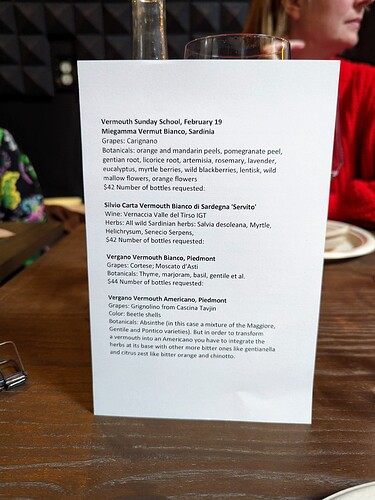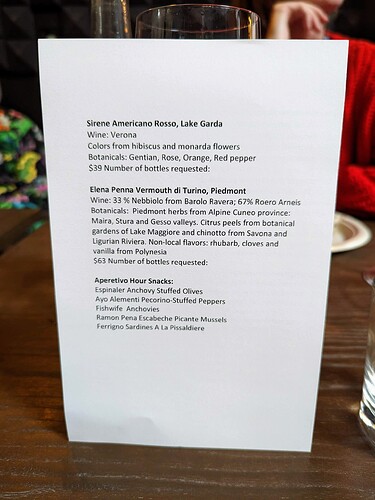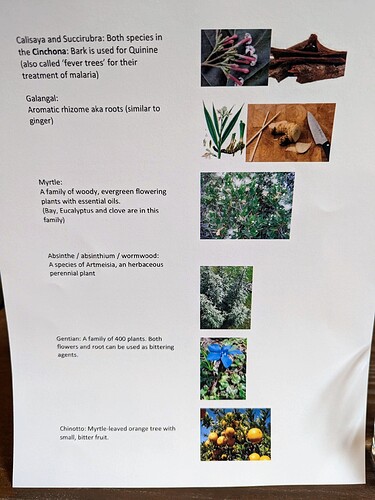Idlewild Sunday School for February featured Italian Vermouth. The Vermouth tasted were all made with the highest quality botanicals and tinctures from herbs, spices, barks, flowers, seeds, roots and more.
Color if used is also all natural including the bright reddish hues from the Cochineal beetle.
Vermouth is classified as “dry” or “sweet” as sugar, caramelized sugar, grape juice etc is often used to balance out the bitterness and alcohol.
All of this adds up to a complex and wonderful array of fragrant notes that make a highly aromatized beverage. The individual Vermouth may or may not be to your liking but all display unique aromatic and flavor qualities.
For the tasting a generous pour was given to evaluate for aroma and sipping quality. A bottle of sparkling water was also provided to splash a bit into the glass to then experience the aromatics with added carbonation. Evaluating without and with carbonation made the perfect format for the tasting.
Miegamma Vermut Bianco, Sardinia: Grapes: Carignano. Botanicals: orange and mandarin peels, pomegranate peel, gentian root, licorice root, artemisia, rosemary, lavender, eucalyptus, myrtle berries, wild blackberries, lentisk, wild mallow flowers, orange flowers.
Sweet herbs, fresh tobacco, orange oil, slightly oxidized mandarin and fig. Lovely aroma. No added sugar. Love it! 16.4% ABV
Silvio Carta Vermouth Bianco di Sardegna “Servito” Sardinia: Wine used: Vernaccia Valle del Tirso. Botanicals: Wild Sardinian herbs, salvia desoleana, myrtle, helichrysum, senecio serpens.
Bergamot, bitter orange, dark cocoa, vanilla, apricot, mint and eucalyptus. Very different and distinct. love it or hate it. Crowd seemed split. I thought it interesting but not my favorite. 16% ABV
Vergano Vermouth Bianco, Piedmont: Grapes: Cortese, Moscato d’ Asti: Botanicals: Thyme, marjoram, basil gentile, other herbs and spices.
Strong marjoram aroma, green herbs, spicy, oregano, mixed citrus, very bitter but delicious. Good stuff! 16% ABV
Vergano Vermouth Americano, Piedmont: Grapes: Grignolino, Color from Cochineal. Botanicals: wormwood, gentian flower & root, rhubarb, chinotto (bitter oranges picked green), sweet orange, galangal and vanilla.
Citrus peel, black pepper, bitter herbs, fig jam, spicy. A favorite of mine and the audience. 16% ABV
Sirene Americano Rosso, Lake Garda: Wine: Verona. Color from hibiscus and monarda flowers. Botanicals: Gentian, rose, orange peel, pepper.
Very floral, rose and violet, wild berry, bitter orange, spicy ginger. Very bitter but balanced with good sweetness. 17% ABV
Elena Penna Vermouth di Turino, Piedmont: Wine: 33% Nebbiolo, 67% Arneis. Botanicals: Piedmont herbs, citrus peels, chinotto, rhubarb, cloves, vanilla.
Perhaps the most complex vermouth of the evening, lot’s of citrus peel, bitter herbs, lot’s of spice, cinnamon, ginger, cloves and a long finish. very bitter but balanced with nice sweetness. 18% ABV
Fantastic tasting of Italian Vermouth none of which I have had before. Should also mention the wonderful snacks we had during the tasting, a mini feast!
Anchovy stuffed olives
Pecorino stuffed peppers
Fishwife anchovies
Picante Mussels
Ferrigno sardines ala Pissaldiere
Forgot to take a photo of the bottles but have included photos of the tasting sheet and a simple introduction sheet of some botanicals used to make vermouth.


